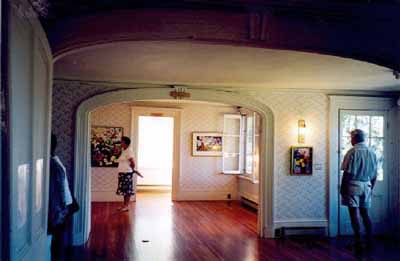Joly de Lotbinière Estate National Historic Site of Canada
Sainte-Croix, Quebec

Interior view
© Agence Parcs Canada / Parks Canada Agency, 2002.
Address :
7015 Route de Pointe Platon, Sainte-Croix, Quebec
Recognition Statute:
Historic Sites and Monuments Act (R.S.C., 1985, c. H-4)
Designation Date:
2003-06-30
Dates:
-
1851 to 1908
(Construction)
Event, Person, Organization:
-
Sir Henri-Gustave Joly de Lotbinière
(Person)
Other Name(s):
-
Joly de Lotbinière Estate
(Designation Name)
Research Report Number:
2002-75
Plaque(s)
Existing plaque: Sainte-Croix, Quebec
Owned by the Joly de Lotbinière family from 1846 to 1967, this estate is a remarkable example of a summer retreat inspired by the Picturesque movement. The propertys long romantic avenue, shaded lawns, ornamental gardens, magnificent century-old black walnut trees and huge house recall the period when members of this eminent family spent their summers here. These exceptionally beautiful grounds reflect the Joly de Lotbinière familys passion for the pursuit of both horticultural research and aesthetic ideals.
Approved 2004
Description of Historic Place
The Joly de Lotbinière Estate National Historic Site of Canada occupies Pointe Platon, a large peninsula on the south shore of the Saint Lawrence River in Quebec. Founded in 1851 by Sir Henri-Gustave Joly de Lotbtinière, an influential Canadian politician and Lieutenant Governor, this 337-acre manorial-style summer estate consists of a large house with landscaped park, specialist gardens and support structures. Designed in the picturesque manner, the estate places an emphasis on the informal and natural. Walkways lead through a succession of gardens containing indigenous and exotic species complemented by lawns, pools and carefully placed trees. Official recognition refers to the estate in its defined boundaries, notably its gardens, as well as the built elements such as buildings and pathways.
Heritage Value
The Joly de Lotbiniere Estate was designated a national historic site of Canada in 2002 because; it is a cultural landscape that is a remarkable example of a summer retreat inspired by the picturesque movement that today is still distinguished by the exceptional quality both aesthetic and experimental, of the grounds; and, it is a testament to the passionate interest in science and the arts shown by several members of the Joly de Lotbinière family, whose work epitomized the efforts of a small number of dedicated amateurs in a position to pursue scientific knowledge and aesthetic ideals.
The Joly de Lotbinière family played an important role from the seigneurial period onwards. Henri-Gustave Joly de Lotbinière, who inherited the estate in 1860, became one of the outstanding politicians of the 19th century, as well as being a remarkable botanist and scientist of that period. The design of the grounds accommodated extensive specimen planting and the establishment of exotic species. Henri-Gustave was also a pioneer of forestry and established a tree collection. The main residence exhibits characteristics of a summer residence including large windows that maximize views of the natural surroundings, and extensive galleries to provide an agreeable transition to the exterior. His grandson inherited the estate and developed the gardens after 1908. Their style is partly English and partly French. The house and the garden have been in public ownership since 1984 and the estate is now open to the public.
Source: Historic Sites and Monuments Board of Canada, Minutes, November 2002.
Character-Defining Elements
The key elements that contribute to the heritage character of this site include: its location on the south shore of the St Lawrence River; its protected site on a peninsula; the design of the estate according to “Gardenesque” principals that include the careful composition of elements in order to produce a “natural” effect based on the teachings of the picturesque movement; the wide variety of specialist vegetable plots, flower beds and plantings and the woodland, pond, meadow, alpine trough garden, the rare plant nursery, as well as the mature trees of different species including Black Walnuts, Oaks, and American Beech; the careful placement of buildings within the composed landscape, including the wooden main house with its three-storey massing under a gable roof, its wooden construction, its large, regularly placed windows and extensive galleries, its projecting frontispiece, the dormer with half-round window, the central entry and the extension at the back with surviving evidence of the original interior configuration, finishes and detailing; the large lawn extending in front of the house, providing a view to the river; the five small support structures, including the former servants quarters, the laboratory, the garage, the gardeners house, the henhouse and wood store, the tool house in their massing, exterior materials and unobtrusive placement; the recreational structures that include the reading kiosk and the “love nest” in their massing, materials, and picturesque placement; the central garden section of the estate, designed as a succession of small gardens forming picturesque landscapes with parterres, pools, indigenous and exotic plants and trees; the woodland to the south and the plantation of Black Walnut trees to the north.